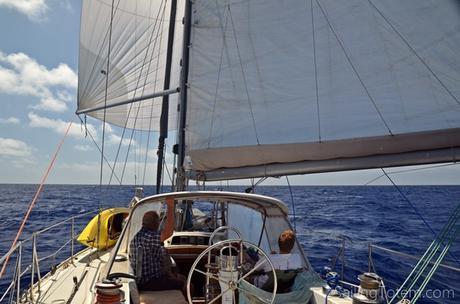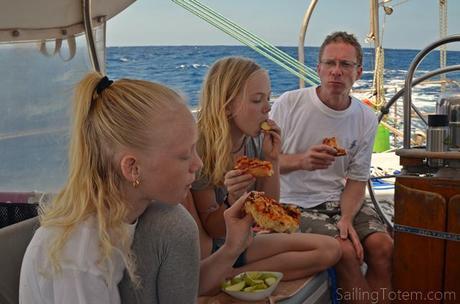

What do you eat on a passage? How do you prepare food for everyone, and have enough on board?
This question came from a few different places after our weeklong sail from Namibia to St Helena. I don’t normally track what we eat, but this time I’d been writing down our meals in the margins of my journal along the way, and offer them here as an example. It’s not a very fair one though as we probably ate better than normal, given the great provisioning (so fresh, so affordable!) in Namibia, coupled with comfortable passage conditions. Meal prep was a lot easier than usual! There was minimal swearing in the galley, despite being on a port tack most of the time.
For this particular passage, we had the boat so stuffed full of food—to minimize purchase until we get to the Caribbean (April) or USA (June)—that we’re overstocked. Finding ingredients is more a question of “where did I put the couscous?” than whether or not we have any.

Apologies to my family. Nobody looks good when they’re eating.
My planning approach is similar for most passages. I keep a list of meals we typically eat underway—it evolves by region, as different foods are easy or hard to find—and check off a mental list of provisions to have for a handful of them. I’ll prep a couple to make the first day or two out as easy as possible, when I’m least feeling like cooking. If we’d expected bad weather- we didn’t- I’d have more prepared for easy heat-and-eat options. If we had needed them, we could have done a few can-dump-meals in adverse conditions.
What’s not typical about these meals is how much I used the oven. In the tropics, it’s simply too hot to do that much baking and roasting. But we had cool weather most of the passage, so it helped warm us and the boat; besides, hot bread makes for a happy crew.
Departure Day
- Croissants with butter and jam
- Tuna sandwiches
- Rendang and rice (Indonesian-style beef curry)
Day 2
- Oatmeal and raisins (it’s COLD!)
- Corn fritters and steamed veggies
- Moroccan beef tagine with couscous (using the more of the delicious Namibian beef)
Day 3
- Eggs and toast
- Fresh focaccia and apples
- Roast chicken, green beans, mashed potatoes and gravy
Day 4
- Scones (oat/fruit/nut)
- Greek salad
- Pasta with zucchini, chard and parmesan
Day 5
- Granola and yogurt
- Salami & cheese sandwiches on fresh bread
- Baked chicken (lemon/smoked paprika marinade), green beans, “halfway cake” (crossed the halfway mark in the wee hours of the morning)
Day 6
- Apple upside down cake (left from the night before)
- Grilled ham & cheese, fruit salad
- Smoked bockwurst, peppers & onions
Day 7
- Fried eggs and potato pancakes (from leftover mashers)
- Melon wrapped with salami
- Enchiladas stuffed with zucchini, chard, and borlotti beans; hot cornbread
Landfall!
- Panfried cornbread (half the reason I make cornbread is to fry it for breakfast)
- Soup & salad
- Pasta with ham, peas, and cream sauce; fresh garlic bread
Besides meals, we always have a couple of grab-as-you-need options. There’s fruit, as long as it lasts, either in a bowl on the counter or at the top of the fridge. A dedicated locker on the port side holds snacks from crackers to nuts and dried fruit. Treats are stashed too: I made gingersnaps before we left Walvis Bay, and have a few bars of dark chocolate to sweeten the wee hours of watch at night. Teenagers with hollow legs can always fill up with a bowl of granola.
I’m thinking of tracking meals again on the coming passage, because it’s probably going downhill from here!

